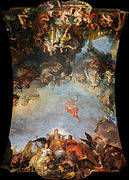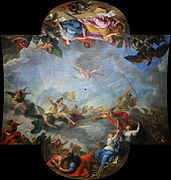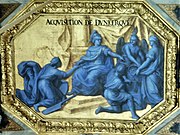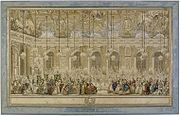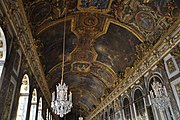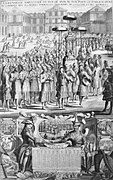Hall of Mirrors

The Hall of Mirrors (French: Grande Galerie, Galerie des Glaces, Galerie de Louis XIV) is a grand Baroque style gallery and one of the most emblematic rooms in the royal Palace of Versailles near Paris, France. The grandiose ensemble of the hall and its adjoining salons was intended to illustrate the power of the absolutist monarch Louis XIV. Located on the first floor (piano nobile) of the palace's central body, it faces west towards the Palace Gardens.[1][2] The Hall of Mirrors has been the scene of events of great historic significance, including the Proclamation of the German Empire and the signing of the Treaty of Versailles.
Cultural and historical background
Construction

In 1623, King
The Hall of Mirrors was built during the third building stage between 1678 and 1684 and was to replace a large terrace and several smaller salons facing the gardens. The terrace was originally situated directly outside of the King's and the Queen's apartments. The terrace was considered to be a rather misplaced architectural element and exposed to the elements, reducing its utility. Eventually it was decided to demolish it and architect Jules Hardouin-Mansart was tasked with the design development and the construction of the Mirror Hall Gallery and artist Charles Le Brun received the honor to create the interior decorative apparatus.[4][5]
The garden facade of the Corps de logis was built in a straight front and essentially received its current appearance. The Hall of Mirrors is flanked at the far ends by the Salon of War (Salon de la guerre) in the north and the Salon of Peace (Salon de la paix) in the south, respectively. The Mirror Gallery connects to the two salons, which were assigned to and incorporated into the king's apartments in the north and the queen's apartments in the south. Both salons are accessible via the Mirror Gallery through wide opening passageways. The hall and the two salons were identically furnished and decorated and form a stylistic and functional unit. The exterior walls of the salons date from the time of Le Vau's encasings of the old château and were given their current appearance after the installation of the Mirror Hall by Hardouin-Mansart.[6][7]
The Hall of Mirrors is—besides the
Arts and decoration

The Mirror Hall's 17 windows open in the direction of the park. On the opposite inside wall of the hall are 17 equally large mirrors, that are composed of more than 350 individual mirror surfaces. On the one hand, the mirrors had an aesthetic function, as the mirror image of the garden depicted the exterior of the castle into the interior of the building and reflected the candlelight in the evening. On the other hand, the mirrors also conveyed the king's wealth and the efficiency of the French economy in a subtle way. Mirror glass was an expensive luxury product in the 17th century and could only be produced with great effort. The manufacture of the mirror surfaces was the first major order for the
Much of the original solid silver furniture of the Hall of Mirrors, famous at the time, was soon lost, particularly the silver Guéridons (tables), which were melted down and coined by order of Louis XIV in 1689 to finance the War of the League of Augsburg. Today's furniture was manufactured during the 19th century after most of the original furnishings were lost during the French Revolution.
Sculptures
The gilded bronze capitals of the Rouge de Rance marble pilasters are decorated with the Fleur-de-lis and Gallic roosters. The gilded bronze trophies, that adorn the green marble Pier glasses, were manufactured by goldsmith Pierre Ladoyreau.
The marble and porphyry busts of eight Roman emperors are accompanied by sculptures of Greek and Roman deities and Muses, such as Bacchus, Venus (Venus of Arles), Modesty, Hermes, Urania, Nemesis and Diana (Diana of Versailles). The latter, moved to the Louvre in 1798, was replaced by a Diana sculpted by René Frémin for the gardens of the Château de Marly until the restoration of the Hall of Mirrors during 2004 to 2007, which in turn was replaced by a copy of the original Diana.[13][14]
Ceiling

The ceiling combines with the mirrors and the light from the western windows to confer on the room its unique character. Nine large and numerous smaller paintings, most of them on canvas using marouflage and the rest directly painted on masonry, are dedicated to the idolization Louis XIV as the Sun King and to the successes of the first two decades of his personal rule (starting in 1661). Charles Le Brun, "the greatest French artist of all time" according to king Louis XIV,[citation needed] directed the ceiling paintings. The central scene is titled The King rules by Himself, highlighting Louis's claim to absolute power and his adversarial stance to rival European powers, the main three of which (the Holy Roman Empire, the United Provinces, and Spain) are depicted on the opposite side of the same panel. The themes of the larger panels center on the Franco-Dutch War of 1672–1678, while the other scenes include episodes of the prior War of Devolution of 1667–1668 and domestic achievements.
According to a contemporary anecdote, the decoration of the eastern wall with mirrors was a ploy by architect Jules Hardouin-Mansart to prevent Le Brun from having even more opportunities to impress Louis with his work.[15][16]
The narrative sequence of the central scenes starts with the formation of the German (Imperial)-Spanish-Dutch alliance in 1672 on the Northern end, and ends with the unraveling of that alliance with the Dutch acceptance of a separate peace with France in 1678. The full list is a compendium of key propaganda themes of the early 1680s, with titles provided by poets Boileau and Racine in their capacity as the regime's official historians:
- Alliance of Germany and Spain with Holland, 1672
- Holland rescued from the bishop of Munster, 1665
- Relief of the people during the famine, 1662
- Reparation of the Corsican Guard's affront in Rome, 1664
- The crossing of the Rhine in front of the enemy, 1672
- The King seizes Maastricht in thirteen days, 1673
- Defeat of the Turks in Hungary by the King's troops, 1664
- The folly of duelling abolished, 1662
- The precedence of France acknowledged by Spain, 1662
- The King gives his orders to simultaneously attack Holland's best-defended strongholds, 1672
- The King ramps up military preparations on land and sea, 1672
- The restoration of France's naval power, 1663
- War against Spain for the Queen's rights, 1667
- The reformation of the justice system, 1667
- The King rules by Himself, 1661
- The pomp of France's neighboring powers
- Order restored to the kingdom's finances, 1662
- The peace concluded in Aix-la-Chapelle, 1668
- Protection awarded to the fine arts, 1663
- Franche-Comté conquered once again, 1674
- Resolution to undertake war against Holland, 1671
- Establishment of the royal institution of Les Invalides, 1674
- Acquisition of Dunkirk, 1662
- Embassies sent from the confines of the Earth
- Takeover of the city and citadel of Ghent in six days, 1678
- Spanish actions countered by the takeover of Ghent
- Renewal of the alliance with the Swiss, 1663
- Safety of the City of Paris], 1665
- The junction of the two seas, 1667
- Holland accepts peace and leaves the alliance with Germany and Spain, 1678
Many of the same themes would be illustrated again a few years later, albeit with a different iconography, in the Louis XIV Victory Monument on Place des Victoires in the center of Paris.
-
The King rules by Himself, 1661 (top) and The pomp of France's neighboring powers (bottom)
-
Takeover of the city and citadel of Gand in six days, 1678 and Spanish actions countered by the takeover of Ghent
-
Order restored to the Kingdom's finances, 1662
-
The peace concluded in Aix-la-Chapelle, 1668
-
Acquisition of Dunkirk, 1662
-
Symbol of Louis XIV
Functions
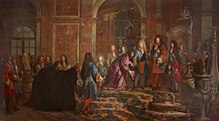

During the 17th century, the hall's main purpose was to serve as a kind of covered promenade for Louis XIV's visit to the chapel. He entered the gallery at least once a day and from 1701, the king's bedroom lay behind the middle wall of the gallery. Courtiers assembled to meet the king and members of the royal family and might make a particular request by intoning: "Sire, Marly?". This was the manner in which nobles were able to obtain a much sought-after invitation to one of the king's house parties at Marly-le-Roi, a villa Louis XIV had built north of Versailles on the route to Saint-Germain-en-Laye.
Its central location and size predestined the Hall of Mirrors as a place for court festivities such as the wedding of the
Foreign audiences were granted, including that of the
The Second
The Hall of Mirrors remains reserved for official ceremonies of the
Gallery
-
Le roi gouverne par lui-même, the modello for the central panel of the ceiling of the Hall of Mirrors c. 1680 by Charles Le Brun, (1619–1690).
-
Mirror panels in the Hall of Mirrors
-
Embassy of Mehemet Raza-Bey, ambassador of the Shah of Persia, 19 February 1715 c. 1715 attributed to Antoine Coypel
-
Turkish Embassy to Louis XV, 1742 by Charles-Nicolas Cochin, (1715–1790)
-
The Ball of the Yew Trees given in February 1745 by Charles-Nicolas Cochin, (1715–1790)
-
Proclamation of the Second German Empire in 1871 by Anton von Werner
-
The eastern facade of the palace before the construction of the Hall of Mirrors, 1675
-
Ceiling of the Hall of Mirrors.
-
Depiction of the Siamese embassy in Versailles, in a 1687 French almanac.
References
- ISBN 978-1-4464-7356-6.
- ISBN 978-0-19-157863-2.
- ^ "Palace of Versailles | palace, Versailles, France". Encyclopædia Britannica. Retrieved 3 May 2020.
- ISBN 978-1-136-78758-4.
- ^ "La galerie des Glaces". Versailles Tourisme. Retrieved 1 May 2020.
- ^ "Palace of Versailles – The Hall of Mirrors". Chateau Versailles. Retrieved 1 May 2020.
- .
- ^ "La galerie des Glaces" (PDF). Chateau Versailles. Retrieved 4 May 2020.
- ^ Riccardo Biancchini (11 February 2019). "Palace of Versailles". In Exhibit. Retrieved 4 May 2020.
- ^ "Hall of Mirrors". David Grubin Productions. 12 September 2006. Retrieved 4 May 2020.
- S2CID 194077148.
- ISBN 9781118314234.
- ^ "Restoration of the Hall of Mirrors gets under way" (PDF). Vinci. 1 July 2004. Retrieved 13 May 2020.
- ^ "The "Grand Versailles" project". Chateau Versailles. Retrieved 13 May 2020.
- ISBN 978-0-300-23719-1.
- ISBN 978-0-300-07743-8.
- ^ "The Hall of Mirrors at The Palace of Versailles". Study com. Retrieved 1 May 2020.
- .
- ^ "Proclamation of the German Empire, 1871". Palace of Versailles. 22 November 2016. Retrieved 7 April 2020.
- ^ "1919 – XXth century – Over the centuries – Versailles 3d". versailles3d.com. Retrieved 7 April 2020.
- ^ Michael Stürmer (1 July 2007). "Versailles, ein Schicksalsort Europas". HISTORY com. Retrieved 3 May 2020.
- ISBN 978-1-58839-622-8.
Further reading
Books
|
Journals
|
External links
![]() Media related to Hall of Mirrors (Palace of Versailles) at Wikimedia Commons
Media related to Hall of Mirrors (Palace of Versailles) at Wikimedia Commons

